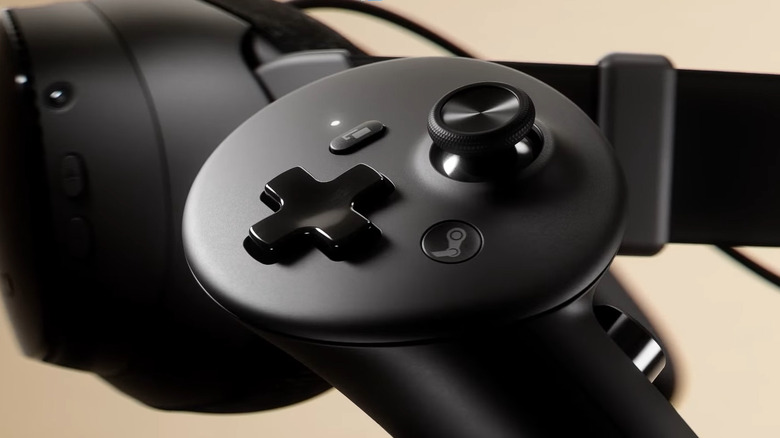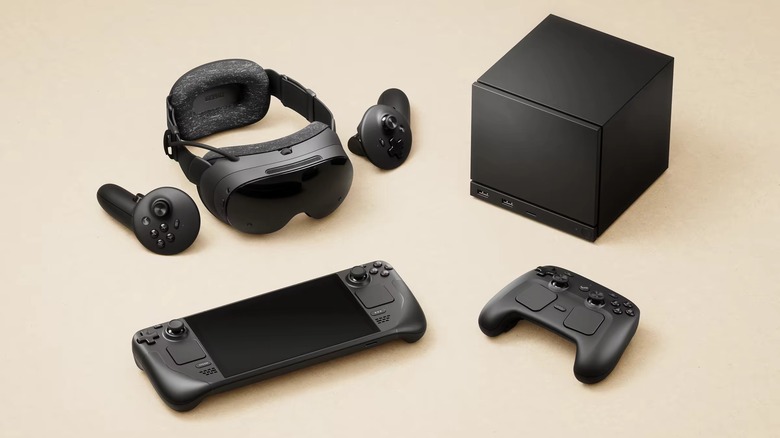If Meta Ruined VR For You, Valve Has Good News
Does anyone still remember the metaverse? You may understandably have zapped it out of your brain to make room for more useful information but, to jog your memory, "metaverse" is a word Mark Zuckerberg stole from a dystopian science fiction novel to describe using a VR headset. The metaverse was hyped up as so revolutionary and game-changing that it necessitated Facebook's rebranding to Meta. A lot of weird stuff happened during the Meta transition (remember when Zuckerberg announced virtual legs like it was some feat of engineering?), and then the company moved on to AI when that became the hot new thing.
Aside from its Quest headsets, Meta seems content to leave the metaverse alone these days. Its attention is focused on making smart glasses and trying to compete in the AI sphere. What the company did to the VR industry, on the other hand, continues to linger like a coal miner's cough. Because Meta wanted VR to be the future of computing, it focused heavily on building out productivity features. You can use your computer in VR, take meetings in VR, and so on. It all basically sucks to use, since nobody wants to sweat into a headset while working on an Excel spreadsheet or fiddle with wires and straps just to take a bathroom break.
Thankfully, one company remembers what was common knowledge before Meta's metaverse failure: VR is for video games. The recently announced Valve Frame is the most exciting virtual reality product I've seen in years, like the first flower blooming in the wreckage of a bombed-out city. Here's why I'm optimistic that Valve and Steam can put the VR industry back on track — and deliver amazing gaming experiences in the process.
Dumping on Meta because I love rubbernecking at train wrecks
Before we get to what could make the Valve Frame a course-correcting product for virtual reality, let's define what made the metaverse such a huge flop. If you were paying any attention to tech news during 2022, you may recall that none of the products Meta released during that feverish time were very good. The quickly discontinued Quest Pro was an overpriced and confusing device ruined by terrible software. It wasn't alone, either: Other companies joined in, including Apple, releasing multi-thousand-dollar headsets which pushed away all but the wealthiest enthusiasts.
The primary blunder was that these headsets focused on productivity. Everyone who used them quickly realized that, although they could be technically impressive, the million tiny frustrations of VR become magnified in enterprise use cases. A VR headset adds friction to everything you do. Instead of flying through the operating system with a mouse and keyboard, you're fiddling with straps and wires, flailing your arms around and pinching the air like some kind of dorky Doctor Strange.
Meta's stench never fully washed off the VR industry. Today, gaming headsets are rare. Instead, we're more likely to get products like the new Samsung Galaxy XR with Google Gemini, where the main selling point is using Android apps and watching sports games in 3D. Remember how 3D TVs flopped over a decade ago? Well, they're back, except now you have to strap them to your head. To quote Detective Benoit Blanc, it's just dumb.
Valve appears to have been watching these developments with a healthy dose of skepticism. And it just bucked the industry trend with a headset that's defiantly focused on gaming.
The Steam Frame remembers where it came from
Valve isn't new to the VR space. The Valve Index, released back in 2019, was widely considered to be among the best PC VR headsets on the market, and it still makes its way onto product recommendation lists over six years later. With the new Frame, Valve has improved on many of the Index's weaknesses, added new strengths, and even improved things nobody thought needed improvement. Or, at least, that's what it says on the box. I wasn't among the press invited to try the headset out in person.
Valve is the biggest name in gaming outside of Sony or Microsoft, and its Steam launcher is practically synonymous with PC gaming. To that end, the Frame is built from the ground up for VR gaming. You can stream games wirelessly from your PC, but the headset also runs games natively because it's loaded with a mobile-grade ARM chip that runs SteamOS. According to those who demoed the headset (in a controlled environment with Valve employees), there was no noticeable latency. That's because of the included 6GHz dongle, which makes a huge difference compared to Wi-Fi streaming on devices like the Quest 3. Valve is using foveated streaming to reduce latency, where only the areas you're looking at are broadcast to the headset in full quality.
It's easy to see that Valve wasn't aiming for splashy gimmicks like Meta and Apple. Instead, the innovations that come with the Frame are technical wizardry that the user isn't supposed to notice. It isn't trying to reinvent the wheel, but to grease the axle. The Frame looks like a godsend for gamers who've grown disillusioned with VR.
Rose-colored smart glasses
Thankfully, Mark Zuckerberg and Tim Cook appear to have given up on their vision of VR headsets as face-clamping tools of office drudgery. Instead, the 600-pound gorillas have moved on to smart glasses. If we ever do end up in a future where editing PDFs in mixed reality is the norm, I suspect it will be because someone finally invented a lightweight pair of glasses that can do everything the Apple Vision Pro does. Zuckerberg may end up having the last laugh there — Meta's collaborations with Ray-Ban are its most successful attempt at getting the masses to stream their lives to its servers.
Meanwhile, I hope the future of full-fat VR headsets looks like the Valve Frame. As it turns out, building a fantastic gaming headset means you've also got a headset that's good at everything else. If it can run AAA games, it can handle emails and spreadsheets. Gaming for long stretches requires a headset that's comfortable even when you're whipping your head around to track objects. By all accounts, the Frame nails this, too, and so it should also be great for productivity.
But the Frame is not a universal device; non-gaming applications are mostly incidental. Some have voiced disappointment at things like the Frame's monochromatic passthrough cameras, but they should be understood as an extension of this philosophy, emphasizing the Frame as a device for immersion rather than augmentation.
Speaking of which, we should talk about the Linux of it all. Valve has built SteamOS, a Linux distribution, to support Windows apps through the Proton compatibility layer. But it also added the surprising ability to side-load Android apps. That's one more area where it invites intriguing comparisons to the Meta Quest.
Valve is keeping things open source
The Meta Quest series of headsets runs on Meta's custom version of Android, which it calls Horizon OS. The platform has come a long way, and it's got some nifty features here and there, but it's a Meta product through and through. You can't do anything with a Quest headset until you sign in with a Meta or Facebook account, and opening the headset up to side-loading requires registering as a developer with Meta. You get the idea — no one moves in Zuck's kingdom without attracting his gaze.
Valve's SteamOS, which powers all of the company's hardware offerings, is built on Arch Linux. Valve requires you to have a Steam account to play Steam games, but nothing's stopping you from running third-party launchers. Want to ignore Steam entirely and play "Fortnite" via the Epic Store? Valve doesn't seem to mind. That's why the announcement that the Frame supports Android APKs is so promising: it means you'll be able to install any app you can find an installer for. This approach is clearly what consumers, or at least gamers, seem to want. Linux now makes up over 3% of Steam users according to the most recent Hardware Survey, and 2025 is the year Linux alternatives to Windows for gamers finally burst out of niche techy communities and recevied mainstream attention.
The Frame is aiming beyond Steam gamers, and that's the real difference between Valve and Meta. The latter sees itself as a kingdom, within the boundaries of which it exerts total control over user behavior, whereas the former acts more like a commune. After all, users consistently choose Steam over other gaming platforms, so Valve has no need for platform lock-in.
VR is back from the metaverse
Valve has remained one of the most fascinating companies in the world, though its empire goes largely under the radar as gaming moves further to the periphery of the tech industry. In a world of metaverses and AI hype, Valve has been strategically positioning itself to assault and claim that fiefdom. It's not a perfect company — those don't exist — but it's focused in a way that's rare in the current tech landscape. The Steam Frame is proof positive of that.
VR headsets will probably never be truly mainstream, so Valve didn't jump the gun by making the Steam Frame a do-everything device. It probably won't sell more units than a Meta Quest 3, but I'd be shocked if it didn't end up the darling of VR gamers. That's a strategy repeated across the newly announced Valve hardware, including the Steam Machine, which lands as Microsoft's commitment to the Xbox no longer feels like a given.
It's not just about the gaming-forward hardware or the open-source software in these products: It's how Valve implemented those elements in a way that's friendly to average users while allowing power users to dive deep. If you want to switch the Frame on and get right into your favorite game, you can, but if you want to be some sort of Linux-powered Geordi LaForge, there's a terminal just a few clicks away.
It's easy to forget that the consumer VR revolution (modest though it was) came about because of gaming. Meta (then Facebook) bought Oculus as a gaming-focused company, and so it remained until Mark Zuckerberg decided "Snowcrash" was a business roadmap rather than a dystopian warning. Thank goodness Valve didn't fall for the hype.





